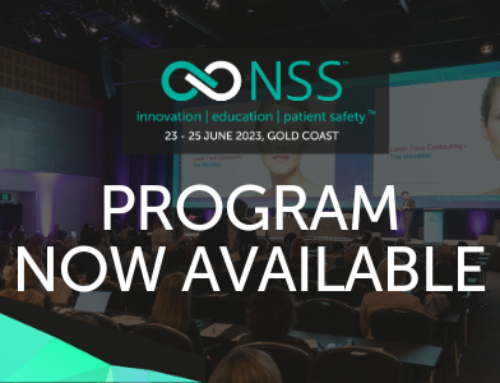The fourth annual Non-Surgical Symposium delivered the very best in technologies and techniques, all harnessed for the client who is happy to forgo the knife.
 Local and international experts arrived at the Melbourne Convention Exhibition Centre earlier this month to share insights into the booming realm of non-surgical enhancement, providing attendees with ‘unbiased and indispensible scientific information on injectables, lasers and other cosmetic treatments,’ explained Dr Tim Papadopoulos, president of the Australian Society of Plastic Surgeons (ASAPS).
Local and international experts arrived at the Melbourne Convention Exhibition Centre earlier this month to share insights into the booming realm of non-surgical enhancement, providing attendees with ‘unbiased and indispensible scientific information on injectables, lasers and other cosmetic treatments,’ explained Dr Tim Papadopoulos, president of the Australian Society of Plastic Surgeons (ASAPS).
Added Dr Gabrielle Caswell, president of the Cosmetic Physicians Society of Australasia (CPSA): ‘As our profession matures it is important to define and refine the respective roles of practitioners. Increasing our personal education and exchanging ideas and techniques with our peers provides maximum benefits for our patients.’
Broad in its scope, the symposium opened with some very simple yet fundamental questions.
Taking to the stage, to present his ‘stepwise approach in facial enhancement for females’, Dr Steven Liew (Shape Clinic, Sydney) asked attendees to consider the very definition of beauty and how detracting from that question can affect client outcomes.
‘If we define beauty as an oval face shape – we’re also looking at specific angles of beauty, flawless skin, an ideal facial outline, facial volume and facial proportion – the face then should not be flat or square, as expected in males, and what we do must work to also improve skin colour and texture,’ said Dr Liew.
He added that this same principle should be applied when working towards gender harmonisation in transgender clients, advising that fillers are most suitable for facial transition.
Keynote guest Dr Hema Sundaram (Sundaram Dermatology, Cosmetic and Laser Surgery Center, Washinton DC) then asked attendees to question the ‘sameness of beauty’ rather than opt to spot differences.
‘The study of ethnicity allows for an appreciation of the sameness of beauty. Ethnicity distinguishes us but also draw us to see our sameness,’ said Dr Sundaram of the three ethnic classifications of Caucasian, Asia and Afro-Caribbean handed down to us by the facial canons of history thanks to Aristotle, Polycleitus and Leonardo da Vinci and even modern-day Disney animations.
‘We need ethnic facial ideals however we often, even subliminally, impose Caucasian ideals on our clients and these can cause disharmony. Yet we must also acknowledge that these ideals can come from the patient as cultural and social overlays inform treatment.’
Dr Sundarum concluded that the globalisation of aesthetics, scales and ideals of beauty mean aestheticians must set realistic goals for the harmony of the client: ‘The aim is facial harmonisation, not rejuvenation. Injectables are your paints and the client’s face is your canvas. We must have respect for this ageing canvas so a conservative, tailored approach is preferred.’
Fellow keynote guest Dr Andr Braz (Clinica Dr Andr Braz, Brazil) also asked guests to take a more theoretical approach when considering client ideals and in particular, that of the management of men.
‘You need to understand the male face, its unique proportions and balance, especially regarding the jaw angle and lower face – the hallmarks of masculinity,’ said Dr Braz.
‘Ask yourselves, how do we define ‘handsome’ and ‘masculine’? Even modern-day vampires have strong jawlines but remember that the simplicity of a beard can help falsify a strong jawline.’
Dr Braz paid specific attention to areas of volume loss and volume displacement in the ageing male, encouraging attendees to make the most of this growing demographic.
 During the remainder of the program, Dr Christopher Lee advised to ‘know how to pick your weapons when it comes to skin rejuvenation, and this includes makeup!”.
During the remainder of the program, Dr Christopher Lee advised to ‘know how to pick your weapons when it comes to skin rejuvenation, and this includes makeup!”.
Dr Des Fernandes celebrated 15 years of the Roller CIT; biochemist Terri Vinson explained not to overlook the opportunity for cellulite treatment in clinics; Beverly Hills based cosmetic surgeion, scientific research and creator of DNA Renewal skincare Dr Ronald Moy showed impressive results from using topical growth factors in thinner areas of the skin … and the experts kept on coming!
This impressive conference proves that clients need no longer be fearful of invasive surgical procedures as a host of non-invasive technologies and techniques continue to improve to achieve desired outcomes from acne to cellulite, skin tone to fine lines. It’s time to put down the knife (more, that is).
Save the date! Non-Surgical Symposium 2016, 2-5 June: www.nonsurgical.org.au
By Spa + Clinic Team








